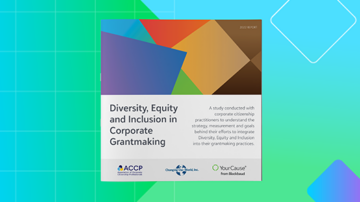DEI in Grantmaking in Action: Taking a Look at Transparency
Throughout the past two years, corporations have faced increased pressures, both internally and externally, not only to donate to a broader range of neglected and underserved populations, but how they go about those donations as well. According to a study by ACCP in 2021, The Impact of COVID-19 and Racial Justice Movement on CSR, 51% of corporate leadership now expect greater integration of DEI into CSR programs.
We recently partnered with ACCP and Changing Our World to conduct a study with CSR practitioners on how their companies are addressing DEI within their corporate giving strategy. 89% of respondent companies have explicitly committed to intentionally addressing DEI or plan to make a commitment in the next year. – Download the report for more data and insights.
It’s clear this initiative is taking the CSR landscape by storm.
However, employees, partners, stakeholders, customers, and the general public are demanding more than a commitment – they want transparent communication. According to the 2022 Edelman Trust Barometer, business is now the most trusted institution above NGOs, government, and media, and a huge part of this trust comes from transparent communications in how companies are conducting business. Companies looking to achieve their DEI commitments will need to take action towards transparent grantmaking practices.
A look at the Principles for Transparency
PEAK Grantmaking has helped funders create strategies for equitable and transparent grantmaking practices for over 25 years. They have worked with advisors and grantmakers to understand what innovative practices look like in connecting the principles of DEI to grantmaking. Their guide, How to be Transparent with Your Grantees, provides three approaches for achieving transparency: Organizational, Process and Decision-making. The guide includes detailed recommendations, checklists and some examples of what fellow grantmakers have done to become more transparent and responsive.1
The grantmaking process for corporations can include multiple systems and interactions. PEAK recommends a good place to start taking the action needed to advance more equitable grantmaking practices is to break down the various parts of the process and ask:
Are we being transparent enough?2
“Process transparency describes the extent to which funders explain and share processes related to applying for, receiving, and reporting on a grant. Funders who pay great attention to process transparency use a wide range of strategies to put this idea into practice such as hosting pre-application sessions or webinars to demystify the grantmaking process, having grant orientation sessions for new grantees, and ensuring that program officers have time to respond to grantee requests.2”
Every organization has a unique mission and goals when it comes to grantmaking that define the process, so there is no one-size fits all way to establishing transparency in grantmaking. Companies that commit to establishing transparency will see many benefits including: strengthening credibility, increasing public trust, improving grantee relationships, reducing duplication effort, facilitating greater collaboration, and building a community of shared learning.3
You can review the references from PEAK Grantmaking and Candid Learning below to learn more about transparency in decision-making, organizational transparency and how to improve transparency practices.
In an effort to continue to provide perspectives on what grantmakers and peer companies are actually doing, Blackbaud has partnered with Shaady Salehi, the Executive Director at the Trust-Based Philanthropy Project, to host a webinar with grantmakers from a community, corporate and independent & family foundation to discuss transparency as a grantmaking strategy. Hear from leaders in the field about tactical ways to embrace transparency, the “faceplant” moments they’ve had along the way and how their foundations have benefited from taking a more transparent approach.
Webinar Details
Transparency as a Grantmaking Strategy to Build Trust and Mutual Accountability
We’ll explore questions such as:
-
How can you be more transparent with prospective grantees about what you do and don’t fund?
-
How can we strive for transparency with current grantees, especially if it has to do with making changes to your funding strategies?
-
How can we remain responsive to our grantee partners amidst our very busy schedules and crowded inboxes?
-
What might we be missing even when we think we’re being transparent and responsive?
Speakers:
Shaady Salehi – Executive Director, Trust-Based Philanthropy Project
Lisa Maloney-Vinz — Director of Global Community Relations, Ecolab Foundation
Drexell Owusu – Chief Impact Officer, The Dallas Foundation
Lauren Scott — Executive Director, Harris and Eliza Kempner Fund
